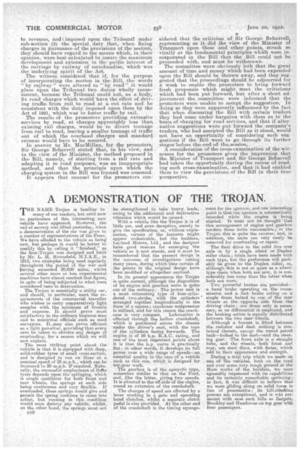A DEMONSTRATION OF THE TROJAN.
Page 10

If you've noticed an error in this article please click here to report it so we can fix it.
THE NAME Trojan is familiar to many of our readers, but until now no particulars of this interesting new vehicle have appeared. However, the veil of secrecy was lifted yesterday, when a demonstration of the car was given to a number of representatives of the Pre,ss. We have alluded to the vehicle as being new, but perhaps it would be better to qualify this by calling it "finished," as the first Trojan was designed and built by -Mr. L. H. flourisfield, M.I.A.E., in 1913, two examples being used regularly throughout the period of the War and ba,ving exceeded 20,000 miles, whilst several other more or less experimental machines have almost reached that figure; in spite of being subjected to what were considerecttests to destruction.
The Trojan is essentially a utility car, and should, in narticular, meet the requirements of the commercial traveller who wishes to carry comparatively light samples with the minimum of trouble' and expense. It should prove most satisfactory to the ordinary business man and to municipal offieiale such as road surveyors. It ..may also prove efficient as a light parcelcar. providing that every care be taken toobviate any danger of overloading, for a reason which we will now explain.
The most striking point about the, vehicle is that it is equipped with deep, solid-rubber tyres of small cross-section, and is designed to run on these at a nominal speed of 25 m.p.h., which can be increased to 30 m.p.h. it'required. Naturally, the successful employment of_tlidte tyres depends upon the springing, which is single cantilever for both front and rear wheels, the springs at each side being continnous and very. flexible. If overloaded, these eprings.would give and permit the spring cushions to come into action, but running in this condition would soon destroy any vehicle, whilst, on the other hand, the springs must not ._ 010
be strengthened to take heavy loads, owing to the additional and destructive vibration which would be caused.
With a vehicle like the Trojan it is of little use, and even deceptive, merely to give the specification, as, without explanation, eel-tam of the features might appear undesirable, but the builders, Leyland Motors, Ltd., and the designer have good reasons for arranging the vehicle as it now stands, and it must be remembered that the present design is the outcome of investigations lasting many years, during which time certain of the points in the original design have been modified or altogether omitted.
In its general appearance the Trojan is suite normal, although the disposition of its engine and gearbox units is quite out of the ordinary. The power unit is a most interesting type of four-cylin dered two-stroke, with the cylinders arranged together longitudinally in the form of a square; crankcase compression is utilized, and for this reason the crank -case is very compact. Lubrication is effected through the hollow crankshaft, which is positioned across the chassis under the driver's seat, with the tops of the cylinders facing forwards. The engine is of 10 h.p. R.A.C. rating, and one of the most important points about it is that, the h.p curve is practically fiat: in other words, it develops its full power over a wide range of speeds—an essential quality in the case of a vehicle such as this one, which is designed for top-gear work.
The gearbox is of the epicyclic type, somewhat similar to that on the Ford, and, like the latter, giving two speeds. It is situated to the off-side of the engine, round an extension of the crankshaft. • The changes of speed are effected by a lever working in a gate and operating band clutches, whilst a separate clutch pedal is also provided. At the other end of the crankshaft is the timing arrange ment for the 'gnaw'', and One interesting point is that tile ignition is automatically retarded while the engine is being started. It must not be thought ' that this arrangement of engine and gearbox renders these units inaccessible; in the Trojan this is quite the reverse, and, in addition the units can very easily be
removed overhauling or repair.
The final drive to the solid live rear axle is by a single silent or Duplex roller chain; trials have been made with each type, but the preference will probably be given to the Duplex roller, a§, although this is not so quiet as a silenttype chain when both are new, it is considerably less noisy thou the latter when both are worn.
Two powerful brakes; are provided— a hand brake operating on the transmission and a foot brake acting on a single drum bolted to one of the rear Wheels at the opposite side from the driving chain; one drum only is necessary, as no differential is employed, and the braking action is equally distributed between the two rear wheels.
Although a bonnet is fitted between the radiator and dash nothing is contained therein, except the round petrol tank—bolted to the dash—and the steering gear. The front. axle is a straight tube, and the wheels, both front and rear, are steel discs, with flutes, -which add to their appearance and strength: During a trial trip which we made On one of the vehicles, both on the road and over some very rough ground at the Ham works of the builders, we were agreeably impressed with its capabilities and its certainly remarkable sprineing; in fact, it was difficult to believe that we were gliding along on solid tyres in lieu of pneumatics; its hill-climbing powers are exceptional, and it will surmot/at with ease such hills as Reigate, Brockley and Handcross.on top gear with four passengers.
































